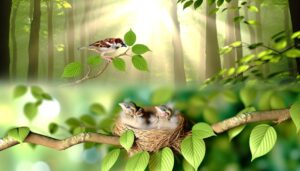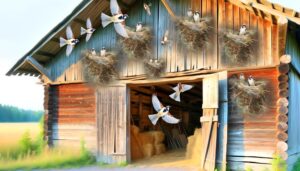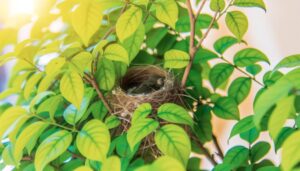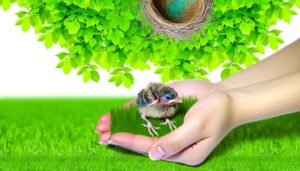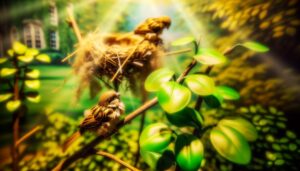10 Steps to Attract Sparrows to Your Nesting Box
To attract sparrows to a nesting box, you should start by placing the box at an ideal height of 6 to 10 feet near shrubs or trees for cover. Use untreated wood for the box, ensuring it has proper ventilation and a sloped roof.
The entrance hole should be appropriately sized with clean edges. Provide dry grasses and feathers as nesting materials and offer a variety of seeds like millet and sunflower.
Install bird baths and maintain cleanliness by regularly inspecting and disinfecting the box. Position the box to avoid direct wind and sunlight, enhancing your chances of success.
Discovering more aspects can further refine your setup.
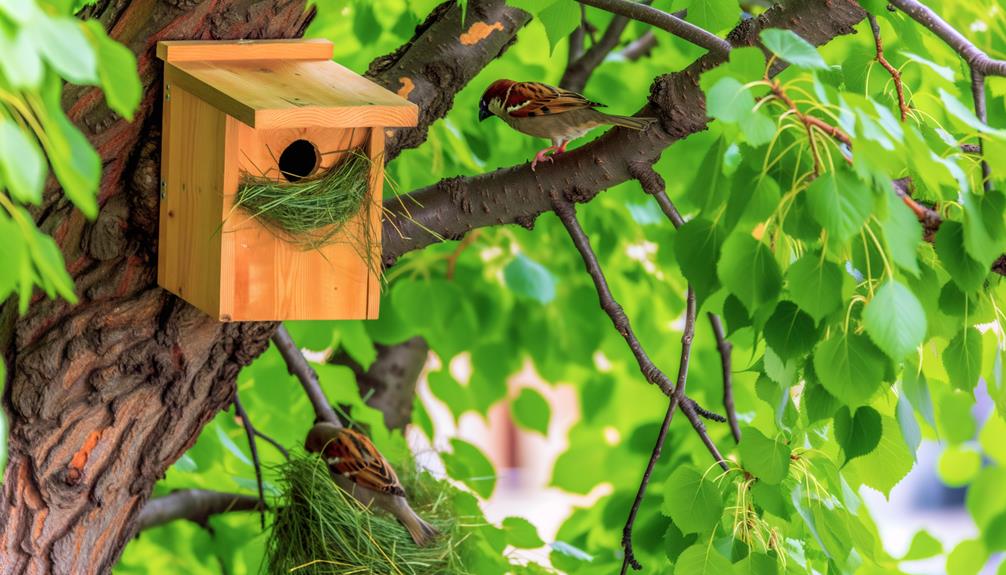
Key Takeaways
- Choose a location near shrubs or trees for cover, away from winds and direct sunlight.
- Use untreated wood with ventilation holes and a sloped roof for temperature control and water runoff.
- Provide natural seeds, grains, and a variety of seeds like millet, sunflower, corn, and oats.
- Maintain cleanliness with regular inspections, cleaning, and removal of droppings and uneaten food.
- Install the nesting box at an optimal height of 6 to 10 feet with a clean entrance hole.
Choosing the Right Location

Selecting the best location for your nesting box is key, as sparrows are known to prefer areas that offer both safety from predators and proximity to food sources. You'll want to place the box at a height between 6 to 10 feet. This elevation minimizes the risk of predation while keeping it accessible for monitoring.
Make sure the site is near shrubs or trees; these provide cover and a launch point for fledglings.
Orientation matters too. Face the entrance away from prevailing winds and direct sunlight to maintain a stable internal temperature.
Selecting the Perfect Nesting Box
To attract sparrows effectively, you'll need a nesting box with specific dimensions and features tailored to their nesting habits. Opt for a box made from untreated wood, as it's both durable and safe for the birds. Make sure the box has ventilation holes to regulate temperature and prevent mold.
A sloped roof will help water runoff, keeping the interior dry. The entrance hole should be appropriately sized to allow sparrows in while deterring larger predators. Position the entrance hole near the top to provide a sense of security.
A removable lid or side panel facilitates easy cleaning, maintaining a healthy environment for the birds. Lastly, include a small perch or landing strip below the entrance to assist sparrows as they enter.
Ensuring Proper Box Dimensions
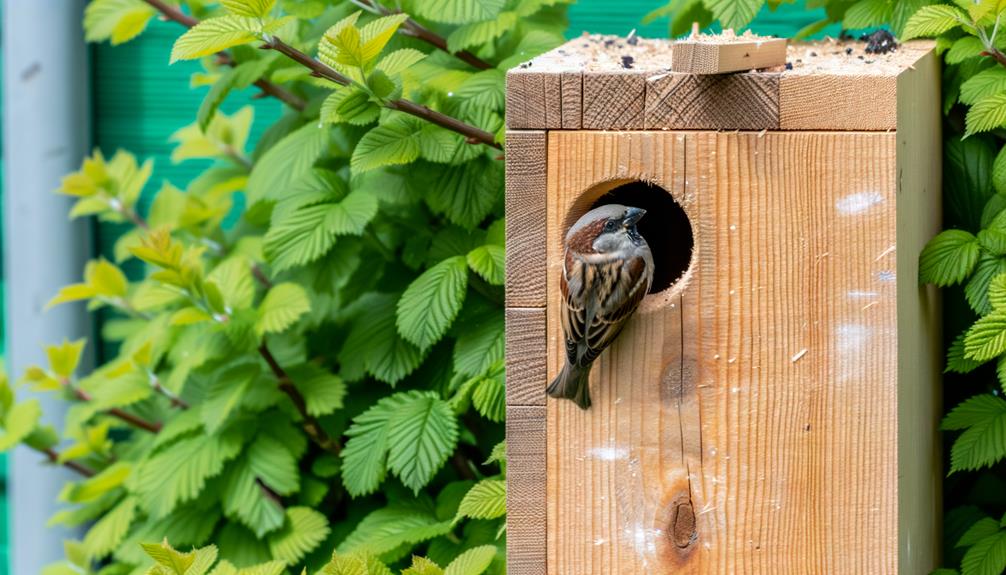
To attract sparrows, you need to guarantee your nesting box has the correct dimensions, starting with an ideal entrance hole size of 1.25 inches. This size prevents larger birds from intruding while accommodating sparrows comfortably.
Additionally, an interior space of about 4×4 inches provides the appropriate room for nesting and raising their young.
Optimal Entrance Hole Size
Determining the best entrance hole size is important for guaranteeing sparrows can comfortably access and utilize the nesting box. A hole diameter of 1.5 inches (3.8 cm) is ideal for most sparrow species, as it allows easy entry while preventing larger, predatory birds from getting inside.
Precision in this measurement guarantees that only smaller birds like sparrows can use the box, thereby enhancing their safety. You should use a drill with a hole saw attachment to create a clean, smooth entrance. Make sure the hole's edges are sanded to avoid injury to the birds.
Appropriate Interior Space
Securing the nesting box has appropriate interior space is vital for sparrows to build their nests comfortably and raise their young. Sparrows need enough room to construct a nest and have space for fledglings to grow.
Here's what you should consider:
- Interior Dimensions: Aim for a floor space of about 4×4 inches. This provides adequate room without making the box too large.
- Height: The box should be approximately 8 inches tall. This height allows for proper ventilation and prevents overcrowding.
- Nest Depth: Leave a gap of 1-2 inches from the bottom to the entrance hole. This helps maintain the nest safe from predators.
- Materials: Use untreated wood with a thickness of at least 3/4 inch to guarantee insulation and durability.
These steps will help you create an inviting and safe nesting environment for sparrows.
Installing the Nesting Box
Position the nesting box at a height of 6 to 10 feet to optimize its attractiveness to sparrows while safeguarding their safety from ground predators.
Mount the box on a sturdy post or tree, making sure it's stable and won't sway in the wind. Face the entrance hole away from prevailing winds to shield the interior from rain and harsh weather conditions.
Place the box in a semi-open area, providing clear flight paths for sparrows. Avoid placing it near bird feeders to minimize the risk of predation.
Regularly inspect the box for signs of wear or damage and confirm it remains securely fastened. By following these guidelines, you'll create a secure and inviting nesting environment for sparrows.
Offering Suitable Nesting Materials
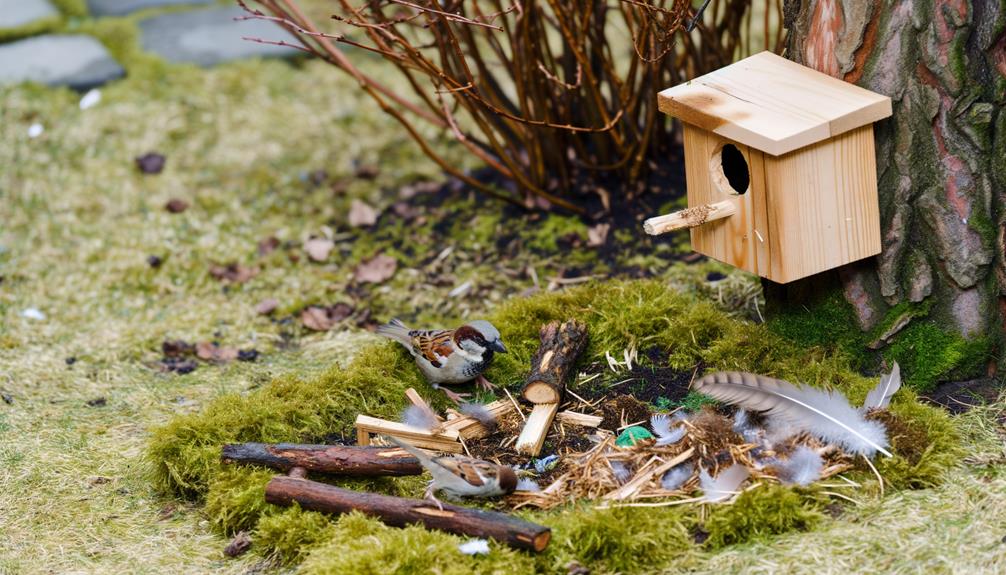
Regularly providing appropriate nesting materials is crucial for encouraging sparrows to settle in your nesting box. Sparrows prefer specific materials that guarantee their nests are warm, secure, and comfortable.
To cater to their needs, consider offering the following:
- Dry grasses: These are lightweight and easy for sparrows to manipulate, forming a solid base for the nest.
- Feathers: Soft and insulating, feathers provide additional warmth and comfort for the eggs and chicks.
- Plant down: The fluffy nature of plant down offers excellent insulation and cushioning properties.
- Small twigs: These add structural integrity to the nest, helping it maintain shape and stability.
Providing Food Sources
To attract sparrows, you should focus on offering natural seeds and grains that mimic their wild diet.
Strategically placing bird feeders near the nesting box will make your yard an ideal habitat.
It's crucial to maintain a consistent supply of food to encourage sparrows to settle and thrive.
Natural Seeds and Grains
When aiming to attract sparrows, offering a variety of natural seeds and grains greatly enhances the chances of making your nesting box their preferred home. Sparrows have specific dietary preferences that, when met, can significantly increase their presence in your yard.
Consider providing:
- Millet: A staple in many birdseed mixes, millet is highly favored by sparrows for its small size and nutritional content.
- Black Oil Sunflower Seeds: Rich in fats and proteins, they're an excellent energy source for sparrows.
- Cracked Corn: Easy for sparrows to consume, cracked corn provides essential carbohydrates for energy.
- Oats: Whole or rolled oats offer a readily available, nutritious option that sparrows find appealing.
Bird Feeders Placement
Strategically situating bird feeders in your yard makes certain sparrows have easy access to food sources, thereby increasing the likelihood they'll choose your nesting box. Position feeders near shrubs or trees, providing sparrows with natural cover and a sense of security. Keep feeders within 10-15 feet of the nesting box to create a convenient foraging area that minimizes energy expenditure.
Opt for feeders that accommodate seeds like millet and sunflower, which are sparrow favorites. Regularly clean and refill feeders to guarantee a consistent food supply. By thoughtfully positioning and maintaining your bird feeders, you create an inviting environment that supports sparrows' nesting habits, contributing significantly to their wellbeing and encouraging them to make your yard their home.
Ensuring Fresh Water Availability
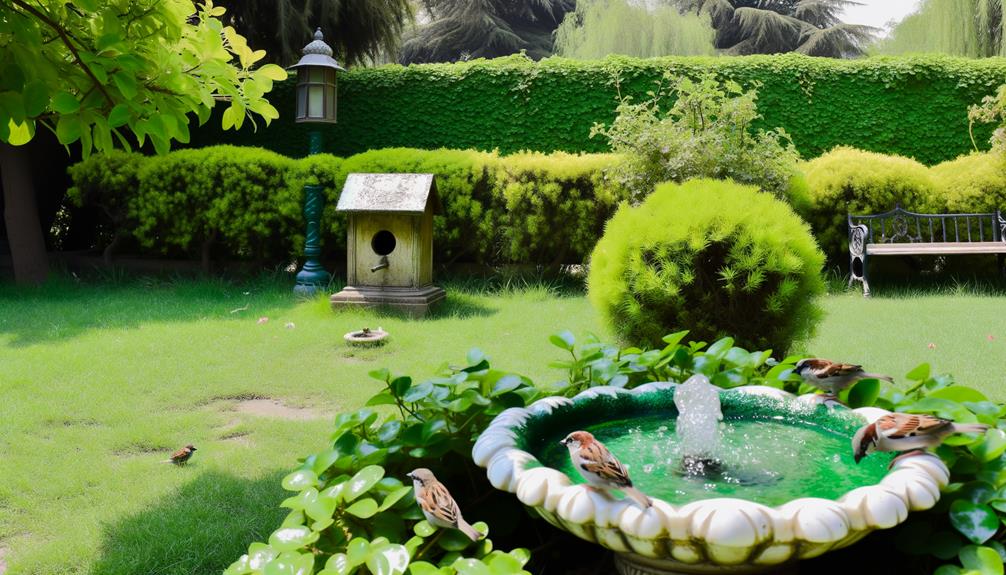
Securing a consistent supply of fresh water can greatly enhance the attractiveness of your nesting box to sparrows, as hydration is vital for their survival and well-being.
To effectively provide fresh water, consider the following steps:
- Install a Bird Bath: Place it near the nesting box. Make sure it's shallow to prevent drowning.
- Change Water Regularly: Fresh water is essential. Refill daily to avoid stagnation and bacterial growth.
- Use a Dripper System: This maintains a steady flow of fresh water, resembling natural sources and attracting sparrows.
- Position in Shade: Keep the water source in a shaded area to maintain a cooler temperature, especially during hot days.
Maintaining Cleanliness
Maintaining a clean environment around the nesting box is essential to prevent diseases and parasites that could harm the sparrows. Regularly inspect the nesting box for droppings, uneaten food, and nesting materials. Remove any debris using a mild disinfectant solution, ensuring you thoroughly rinse and dry the box before reattaching it.
Also, clean the surrounding area to deter pests and mold growth. Monitor the nesting box at least once a month, especially during breeding season, to promptly address any cleanliness issues. Consider wearing gloves when cleaning to protect yourself and minimize contamination.
Protecting From Predators
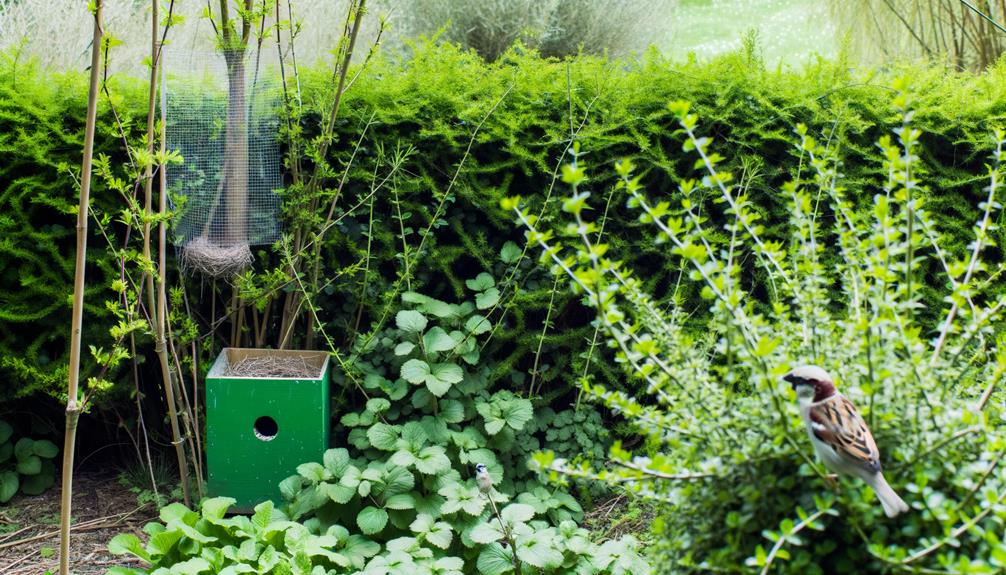
To protect sparrows from predators, place the nesting box at least 10 feet above the ground and away from dense foliage where cats or snakes might conceal themselves. This height deters many ground predators and reduces the risk of unexpected attacks.
Additionally, consider these measures:
- Predator Guards: Attach baffles or cone-shaped guards below the box to hinder climbing.
- Entrance Hole Size: Make sure the entrance hole is no larger than 1.5 inches to exclude larger birds or mammals.
- Metal Plates: Set up metal plates around the entrance to prevent gnawing by squirrels or other animals.
- Secure Mounting: Securely fasten the box to prevent it from being knocked down by persistent predators.
These steps will help establish a safer environment for sparrows, encouraging successful nesting.
Monitoring and Observation
To effectively monitor sparrow activity, you should conduct regular nest checkups to assess the condition and occupancy of the nesting box.
Identifying sparrow activity involves observing specific behaviors such as nest building and feeding patterns.
Regular Nest Checkups
Regularly inspecting your sparrow nesting box is essential for ensuring the health and safety of both the birds and their developing offspring. To effectively monitor the nest, follow these steps:
- Schedule regular inspections: Aim for weekly checks, preferably in the morning when sparrows are less active.
- Wear gloves and use proper tools: This prevents the transmission of diseases and minimizes disturbance to the nest.
- Observe without interference: Look for signs of healthy chicks and note any irregularities, such as the presence of parasites or unhatched eggs.
- Record observations: Keep a detailed log of each checkup, documenting dates, conditions, and any interventions taken.
Identify Sparrow Activity
When monitoring sparrow activity, it's crucial to systematically observe their behaviors and interactions around the nesting box to gather accurate data on their nesting habits.
Begin by noting the frequency and times of day sparrows visit the box. Pay close attention to their vocalizations, as calls can indicate territorial claims or courtship.
Watch for any carrying of nesting materials, a clear sign they've chosen your box. Additionally, track any aggressive interactions; these can influence nesting success.
Use binoculars for detailed observation without disturbing the birds. Consistent monitoring will help you understand their patterns and needs, enabling you to adjust the environment for best nesting.
Your diligent observation directly aids sparrows, fostering a thriving avian community.
Record Nesting Patterns
Start by creating a systematic schedule to document the specific times sparrows engage in nesting activities, noting both the duration and frequency of each visit. This data will provide valuable insights into their patterns and behaviors.
To effectively record nesting patterns, follow these steps:
- Daily Logs: Record observations at the same time each day to maintain consistency.
- Behavioral Notes: Note specific behaviors such as nest building, feeding, and brooding.
- Environmental Factors: Document weather conditions and any disturbances that could impact nesting.
- Photographic Evidence: Use a camera to capture key moments, making sure you have a visual record.
Encouraging a Sparrow-Friendly Habitat
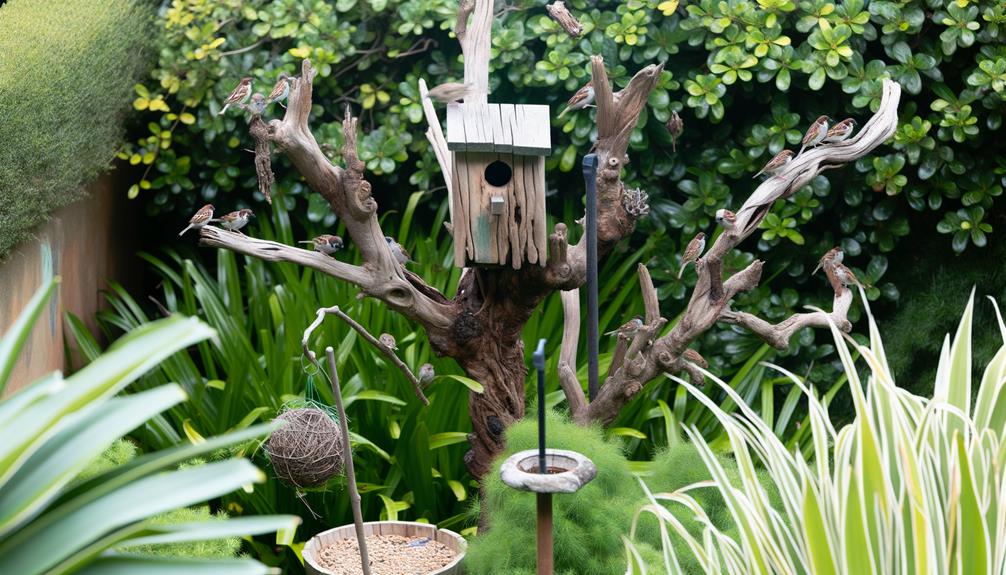
Creating a sparrow-friendly habitat involves providing essential elements like food sources, water, and shelter, tailored to meet the specific needs of these birds.
You should plant native grasses and shrubs to offer natural foraging opportunities. Install feeders with seeds such as millet and sunflower, which sparrows favor. Ensure a reliable water source by setting up a shallow birdbath, cleaning it regularly to prevent disease.
For shelter, dense shrubs and small trees provide protection from predators and harsh weather. Avoid using pesticides, as they can harm sparrows and reduce insect populations, an essential food source.
Conclusion
So, you've set up the perfect nesting box: ideal location, precise dimensions, and predator-proof. You've even provided the coziest nesting materials.
Ironically, after all this meticulous effort, sparrows might still prefer your neighbor's old, dilapidated birdhouse over your scientific marvel. Nature, it seems, thrives on unpredictability.
Yet, your detailed, analytical approach does increase the odds. Keep observing, adapting, and remember, in the intricate dance of nature, sometimes the sparrows have the final say.

